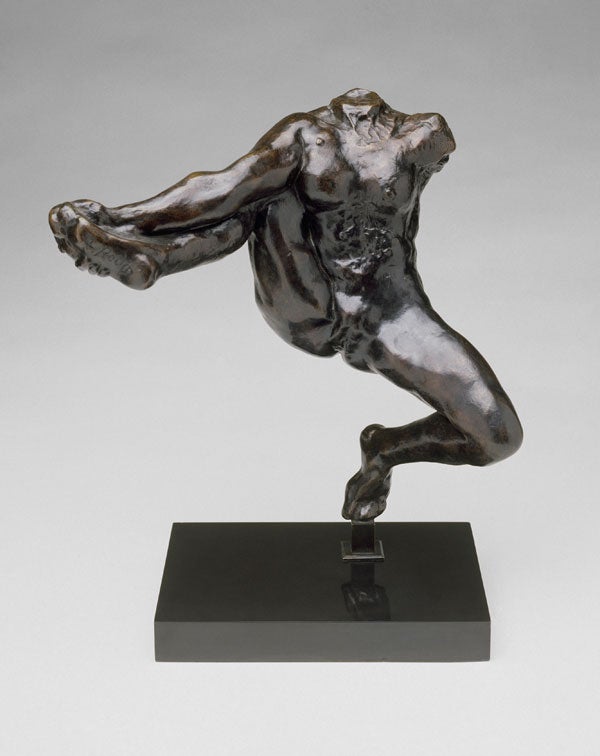Great Works: Iris, Messenger of the Gods (circa 1895), Auguste Rodin
Metropolitan Museum of Art, New York

We see – in fact, we almost breathlessly catch her in our waiting arms – the naked, headless, one-armed figure of the young woman, in flight in mid-air, all sweat and noise and energetic clamour. She is flying at us, about to hit us in the chest, legs wildly, almost painfully, splayed, horrifyingly athletic, and full of vaunting sexual promise. Our eyes seem to pivot about her swelling vulva. Rodin did many such sculptures, leaping, flinging, flowing, dancing. And they all share a common theme: untrammelled energy.
She is Iris, Messenger of the Gods, on an urgent mission to persuade us that sculpture has a vigorous future after all – as Rodin, who made this fragment in about 1895, so urgently believed. Too much sculpture, before and after Rodin, has seemed to embody an almost studiedly monumental lifelessness, and especially much of the sculpture which is commissioned to go on public display. Think of the ridiculous travesty which currently passes for figurative sculpture at St. Pancras International terminal, for example. Its leadenness makes a mockery of sculpture's potential to represent three-dimensional form in the round. Iris could not be more different. She could scarcely be more sculpturally alive and alight than she is in this relatively small bronze – yes, she looks and feels larger than she is. In part, that is to do with her poise and her pugnacity.
She has a provisional, untamed look about her, as if she has burst in upon us without invitation, with a shriek. We notice that before this casting in bronze – and even though the formal perfection of bronze casting tends, in part at least, to smooth these things away – she had been quite roughly, even hectically, moulded in plaster. Rodin liked to work like this, hands on, with clay or plaster.
What is more, she is not even completely herself. She is a fragment, not a whole. She is both a fragment of herself, and a fragment of a larger thing. The larger thing was to have been a monument to Victor Hugo destined for the Panthéon entitled The Apotheosis of Victor Hugo. It was never finished. So Rodin, a collagist by instinct, did something different with the piece. He left it to stand defiantly alone as a model of fearless sexual self-display. This was not uncommon with Rodin. He was forever mixing and matching up bits and pieces of sculpture from here and there at his studio in Meudon.
See how Iris's left arm seems to have been almost ripped away, by the hacking of some furious blade. The way that this fragment of an arm terminates, so jaggily, that seemingly brutish act of ripping away, adds to its dynamism, to the feeling that we are witnessing violent activity. She could be about to leap over our heads, such is her energetic mood and posture. Does this sculpture not seem, in its lack of prudishness and its fearless, full-front showiness, to have set its face against the prudishness of the 19th century? And yet it was made at the tail end of that century.
A technical matter. Consider the height at which it is displayed. This is of crucial importance too. See how it is raised up so that we confront it, body to body, just as Rodin would have wished. Rodin was very punctilious about this question of height of display. A few years ago there was an entire exhibition devoted to the subject at the Rodin Museum in Paris. The single most revelatory ensemble of figures to be seen there was The Burghers of Calais, which was raised up high on a wooden scaffolding. This is just as Rodin had originally intended – there were fading photographs to prove it. We had to look up into the faces of the burghers. And in so doing, they came alive. Their heroic struggle had the meaning of which it has been completely robbed as we see it now in Victoria Tower Gardens, where the burghers stand on a low plinth, unenergised, lacking in purposefulness, robbed of meaning.
What then are the multiple meanings of this flighty pagan messenger? She represents the sudden onrush of artistic creativity, how it strikes the artist unawares. As with creation itself, one moment there is nothing, and then there is something. The way this female presence is almost brutally thrust into our faces also puts us in mind of Gustave Courbet's great, long-suppressed erotic masterpiece, The Origin of the World, which had been painted 30 years earlier. These are both images of the genetrix, so potent, so unstoppably vital.
ABOUT THE ARTIST
Auguste Rodin (1840-1917) was the most important sculptor of the 19th century. His works range from portraits of the most celebrated men of his day – including Victor Hugo and Honoré de Balzac – through major public commissions, to many small-scale works of dancers in movement, which are amongst his most expressive works.
Subscribe to Independent Premium to bookmark this article
Want to bookmark your favourite articles and stories to read or reference later? Start your Independent Premium subscription today.

Join our commenting forum
Join thought-provoking conversations, follow other Independent readers and see their replies